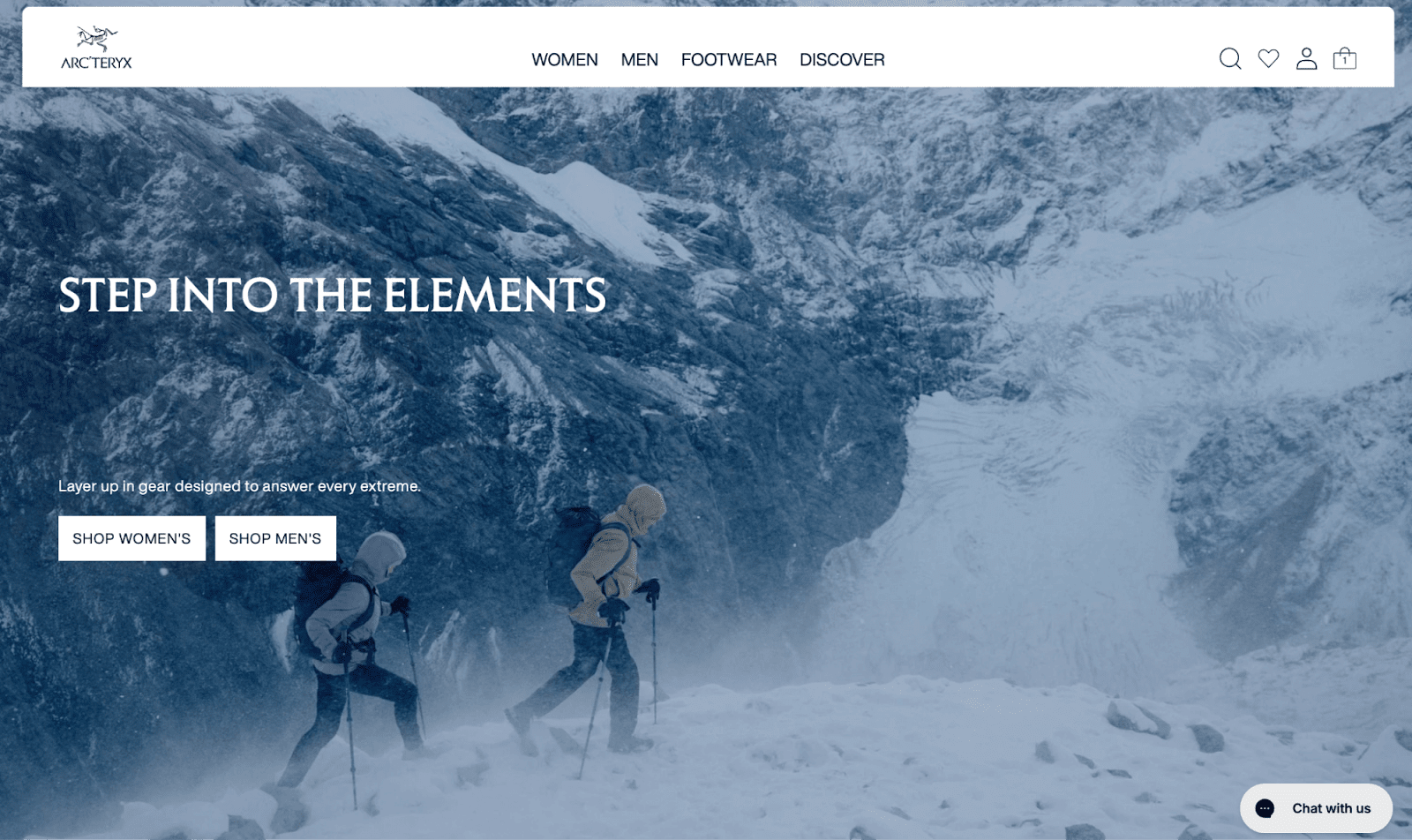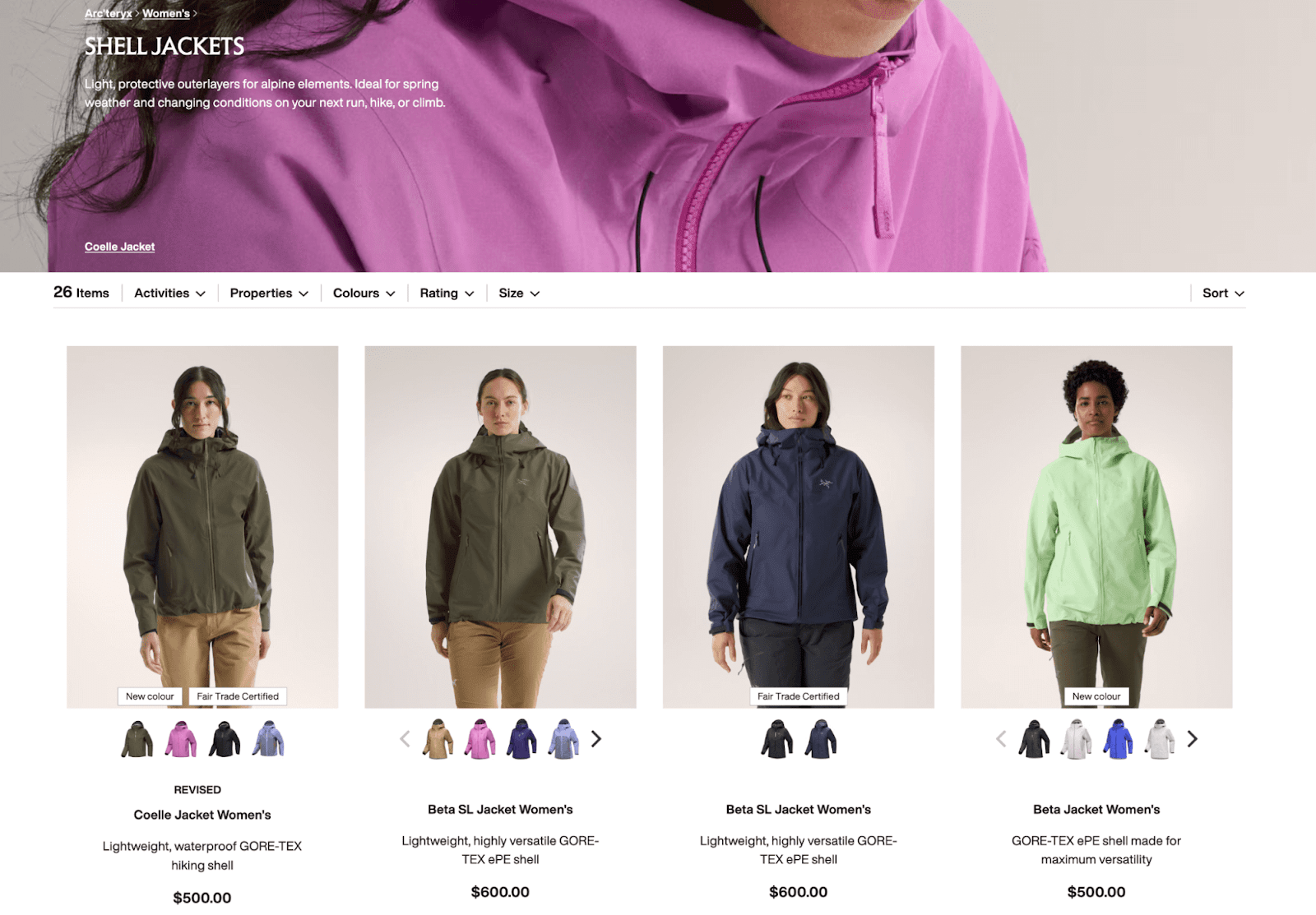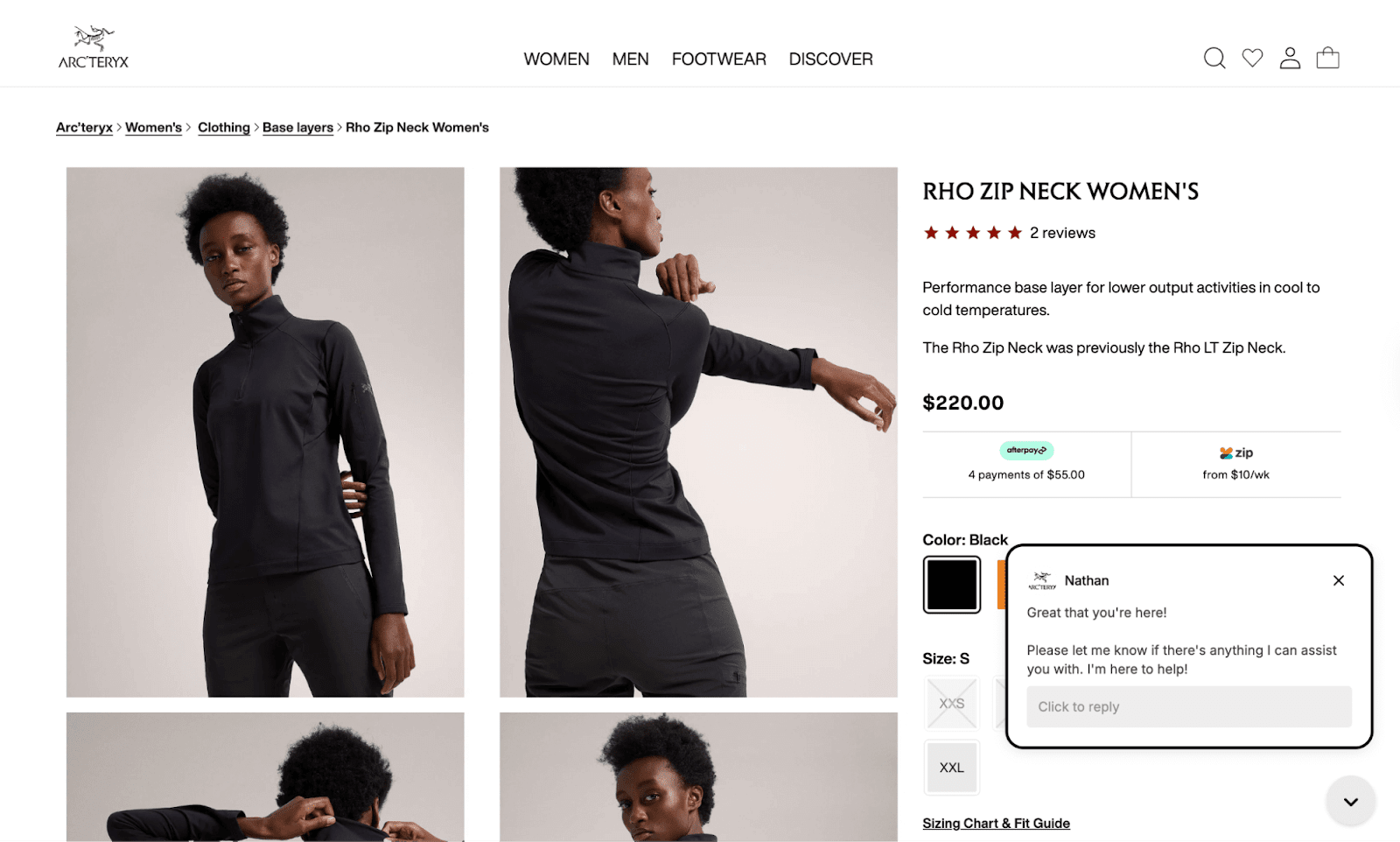.avif)
How Arc’teryx’s Conversion Rate Climbed 75% With Shopping Assistant
Challenge: As a premium outerwear brand, Arc’teryx faced a high volume of pre-purchase questions about the nuanced technical differences between its wide variety of SKUs across multiple product collections. Without immediate, accurate, and educational responses, customers were unsure if the product would work for them, leading to hesitation and cart abandonment.
Solution: Arc’teryx introduced Shopping Assistant and proactive engagement campaigns to simplify product navigation, enhance product education, and deliver tailored product recommendations based on customer needs. This gave customers a deeper understanding of each product, resulting in greater purchase confidence, AOV, and conversion rates.
About Arc’teryx
Founded in 1989 by a group of avid climbers in Canada, Arc’teryx is now a globally recognized technical outerwear and apparel brand. Adventurers love it for its performance gear tailored to alpine sports.

In Australia, Arc’teryx is rapidly growing under the Amer Sports umbrella, alongside Wilson and Salomon. The team has two full-time dedicated CX agents who use Gorgias to manage customer conversations, most of which focus on pre-purchase inquiries since the products are highly technical. This created an opportunity to utilize AI to provide detailed, hyper-personalized product explanations and recommendations that ultimately drove more sales.
The challenge: Helping customers choose the right gear without overwhelming a lean CX team
Arc’teryx needed a way to improve pre-purchase engagement, help customers make informed product choices, and reduce the burden on their small CX team.
“Because of the premium price point, people tend to do more research and ask more questions before purchasing,” Nathan Larner, Customer Experience Advisor for Arc’teryx, explains. This meant the inbox filled up with technical product pre-purchase questions, such as, “Which shell is right for ski touring vs. hiking?” Without immediate, accurate responses, Arc’teryx risked losing those sales forever.
“Before Shopping Assistant, we didn’t have a strategy to drive revenue through CX. Our focus was solely on helping customers with issues, not selling products.”
—Nathan Larner, Customer Experience Advisor for Arc’teryx
Given that there are over twenty-five product variants listed in its Women’s Shell Jackets product collection, it’s no surprise that finding the best one can be challenging.
“We’ve got a large range of shell jackets—rain jackets, snow jackets, ski jackets—and they’re all intended for really specific uses. Customers are often unsure if they’ll work for their intended activity, making pre-sales education a critical step in the buying process.”
—Nathan Larner, Customer Experience Advisor for Arc’teryx

Arc’teryx’s CX team lacked scalable tools to efficiently handle these pre-purchase questions, especially without compromising the brand's voice or sales strategy. As a premium brand, Arc’teryx doesn’t offer discount codes, so whatever tool they went with had to maintain an educational and helpful tone that communicates the products’ value.
The solution: AI-powered pre-sales conversations simplify the path to purchase
Arc’teryx implemented proactive engagement campaigns and Shopping Assistant to proactively start conversations, guide customers through complex choices, and free up agents to focus on long-term CX innovation.
With AI Agent already onboarded for repetitive support tickets, Arc’teryx implemented Shopping Assistant to handle pre-purchase inquiries and specific product questions. Shopping Assistant immediately began utilizing the 100+ article knowledge base and AI Guidance documents to deliver virtual sales assistance that aligned with Arc’teryx’s brand tone and voice.
“Shopping Assistant was super easy to set up. We just toggled it on and adjusted the slider to match our brand’s educational tone. It was basically ready to go out of the box.”
—Nathan Larner, Customer Experience Advisor for Arc’teryx
Shopping Assistant breaks down nuanced differences between similar SKUs
Even the most skilled hikers and mountaineers can get lost. This was the case for many of Arc’teryx’s customers as they navigated a growing online product catalog.
With a wide range of similar products, customers often reached out to clarify the differences between products in the same line. For instance, Arc’teryx’s CX team was answering repetitive questions like:
- Which shell jackets are best for climbing vs. snowboarding?
- Which trail running shoe is best for long distances?
- What is the difference between the Nita Insulated Pants and the Sentinel Pants?
These high-intent questions are valuable if answered promptly and correctly. However, if they linger in the inbox, customers will likely exit the chat and leave the site, abandoning their purchase.
For example, a customer reaches out to ask about the difference between the Beta AR Jacket and the Beta SL Jacket, and which is better for skiing in cold climates:
Shopping Assistant chimes in to explain the features and benefits of each jacket, ultimately upselling the customer by recommending the Beta AR Jacket. It closes the conversation naturally by asking if the shopper needs help with sizing or recommendations for complementary products.
“It’s been awesome to see Shopping Assistant guide customers through our technical product range without any human input. It’s a much smoother journey for the shopper.”
—Nathan Larner, Customer Experience Advisor for Arc’teryx
Proactively engaging high-intent shoppers before they bounce
Arc’teryx pairs Shopping Assistant with proactive chat campaigns to engage shoppers when they signal certain behaviors.
For example, if a customer views technical items or popular products, they’re greeted with a message welcoming them and asking if they need any more help.

Once a customer clicks the reply box, they trigger a live chat with Shopping Assistant, which can then guide them to a product recommendation.
In this example, a customer inquires about the suitability of the Rho Zip Neck Women’s base layer for skiing or hiking while viewing the product page. Since Shopping Assistant is context-aware, it immediately answers their question without having to ask follow-up questions to confirm what product they’re referring to.
This quick interaction gives the customer the information they need, reduces their hesitation, and gives them the confidence to add the item to their cart.
Helping shoppers navigate international sizing conversions
As a global brand, Arc’teryx sells to customers worldwide. As customers visit the online store in different countries, they face challenges like:
- Size confusion across regions, especially between UK, US, EU, and Asian sizing systems
- Uncertainty around fit, leading to cart abandonment or over-reliance on manual size charts
- Customer frustration and increased returns when buyers select incorrect sizes due to a lack of real-time assistance
Arc’teryx knew that size confusion was a conversion killer—without clarity, shoppers hesitate to buy or make returns that eat into margins. Arc’teryx was losing out when customers left the site to “double-check” sizing and never returned, and when agents spent valuable time handling repetitive size conversion questions.
Shopping Assistant helps convert this uncertainty into confident purchases by:
- Automatically translating sizing across regions, based on the shopper's location, preferences, or past purchases
- Providing clear, conversational fit guidance like, “In US sizing, you’d likely wear a Medium in this jacket.”
- Linking to customer-fit reviews or model sizing info to offer additional confidence, such as “This fits true to size—94% of customers kept their original size.”
For instance, a shopper viewing the Kopec Mid GTX Boot page reaches out with a sizing question, “I’m usually a US size 8. What is the corresponding UK size?”
Using the size conversion chart in the AI knowledge sources, Shopping Assistant immediately informs the customer that they’d likely be a UK size 5.5 or 6.
The results: Larger baskets, fewer abandoned carts, and more conversions
Shopping Assistant transformed Arc’teryx’s customer experience, handling the majority of pre-purchase inquiries and turning them into revenue.
Within 30 days, Shopping Assistant helped Arc’teryx achieve:
- 75% increase in conversion rate (from 4% to 7%)
- 23x ROI on AI Agent
- 3.7% revenue influenced rate by Shopping Assistant
Aside from the financial gains, Shopping Assistant improved the shopper and agent experiences by:
- Giving customers a deeper understanding of technical product specs—enhancing satisfaction and decreasing cart friction
- Guiding customers away from browsing fatigue and toward confidence in high-ticket purchases
- Instantly responding to customers to avoid disrupting the experience, even for complex needs like warranty questions that were handed over to human agents
“It’s helping us have way more conversations at a much faster rate. Shoppers aren’t stuck waiting on an agent anymore.”
—Nathan Larner, Customer Experience Advisor for Arc’teryx
Start engaging high-intent shoppers with AI-powered conversations that drives real results. Book a demo to see Shopping Assistant in action.
How other brands are growing with Gorgias
Please update or reset all









